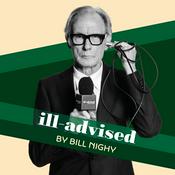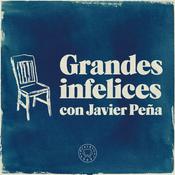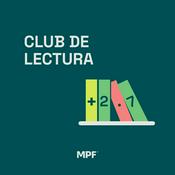Episodios disponibles
5 de 121
- Nikki Ogunnaike (Editor: Marie Claire, more)A MODERN MAGAZINE EDITOR IN A POST-MAGAZINE WORLD—In the media storm that is 2025, the person you want captaining your ship is smart, decisive, and cool, calm, and collected—in other words, she’s Nikki Ogunnaike.The editor-in-chief of Marie Claire, whom we got to know when we worked together at Elle, is the very model of a modern magazine editor, in that—unlike the lifers of old—she hopscotched through a ton of jobs, accruing skills as a writer, a fashion editor, a digital editor and a print editor, and, oh yeah, a social-media savvy multi-platform operator—to become what she is now: someone uniquely equipped to lead a new era of Marie Claire.We talked to Nikki about what it’s like to run a modern media brand in a post-magazine world—what does the job of “magazine editor” even mean now? Also: how is the post-Hearst Marie Claire evolving to meet a new reader, or should we say “follower,” and which parts of its original DNA Nikki is working to preserve. Also: Is the “girlboss” back?—This episode is made possible by our friends at Commercial Type and Freeport Press. A production of Magazeum LLC ©2021–2025--------43:31
- Kade Krichko (Founder: Ori)THE PURPOSE OF TRAVEL—The world is adrift in travel magazines that tell you to go here and stay there, to order certain foods at “of-the-moment” restaurants. And when you go to these places you find yourself surrounded by other travelers like you, and the only locals you interact with are, maybe, the waiter, or your Airbnb host, or the tour guide taking you on a generic definitely-not-what-the-locals-do tour of the trendiest neighborhood in town. Or you might not even meet a local. Or ever stop looking at the screen on your phone.You will have ticked items off your travel bucket list, but will you have actually traveled? Travel becomes consumption and as with all manner of consumption, you are never quite sated, and hey, there’s a media ecosystem out there to help you along.And then there’s Ori. Founded by journalist Kade Krichko, Ori bills itself as a “travel, art and education platform” that allows local storytellers to tell their stories on a global scale. It is a magazine that understands travel is an experience first and foremost, and that traveling well means an immersion into people and places, an opportunity to grow and to heal.It’s a magazine that assumes you should think about and experience the world around you, and that if you think about it and experience it enough, the world becomes a more interconnected and better place; it becomes a place of wonder.And isn’t that why we travel?—This episode is made possible by our friends at Freeport Press. A production of Magazeum LLC ©2021–2025--------38:20
- Susan Casey (Editor: O, The Oprah Magazine; Designer: Outside; Writer: Esquire; Best-Selling Author)PART OF THE STORY—Susan Casey has won National Magazine Awards for editing, writing, and design—a feat that may well be unprecedented in the industry’s history.In her native Canada, they call people like this “Wayne Gretzky.”She has worked—under various titles—for the following magazines: The Globe & Mail, Outside, Time, Esquire, eCompany, Business 2.0, Sports Illustrated Women, National Geographic, Fortune, and O, The Oprah Magazine. She also worked for the iconic 1990s fashion brand Esprit. These days—literally on any given day—you’re likely to find Casey in the water, where she spent much of her childhood, later with the swim team at the University of Arizona, and, as an adult, as the author of four immersive books—all best sellers—about the ocean: The Wave: In Pursuit of the Rogues, Freaks, and Giants of the Ocean; The Devil’s Teeth: A True Story of Obsession and Survival Among America’s Great White Sharks; Voices in the Ocean: A Journey Into the Wild and Haunting World of Dolphins; and her most recent, The Underworld: Journeys to the Depths of the Ocean.A self-proclaimed “outspoken designer” early in her career, she refused to accept the career path limits others imposed and instead laid the groundwork for a rich creative life.—This episode is made possible by our friends at Commercial Type and Freeport Press. A production of Magazeum LLC ©2021–2025--------1:00:42
- Kyle Yoshioka (Editor: Provecho)FOOD IS FOR EVERYONE—That meal your grandmother always cooked. Or your mother. Or your father, for that matter. The odors that permeated a kitchen or the entire house. The first taste. The idea of comfort food.So much of who we are and what we remember are about food, sure, but also about place, and most definitely about the person doing the cooking.While many food magazines go beyond food to create the context about the recipes they print, writer and editor Kyle Yoshioka felt they lacked the backstories that make food about more than taste or trends or wine accompaniments. And with no experience in the form, he was part of a team in Portland, Oregon that decided to launch Provecho, a magazine all about the backstories, and especially the culture and communities, behind each and every ingredient that goes into each and every lovingly created dish. And without a single recipe.Provecho, then, is not really a food magazine at all, but a cultural review that uses food as a focal point. It’s anthropology that tastes good. One that is, in its own way, creating a community all its own.—This episode is made possible by our friends at Freeport Press. A production of Magazeum LLC ©2021–2025--------35:36
- Charles Emmerson (Founder: Translator)LOST IN TRANSLATOR—There are more than 7,000 languages in the world and there’s a good chance that you don’t speak or read most of them. Being an English-language speaker is, among other things, a huge privilege in this multilingual world because while it may not be the most widely spoken first language, English is the language that is most widely spoken.There’s a chance that you can get by in English almost everywhere. And so English speakers tend not to learn other languages. To their detriment. (And to the resentment of others. But that’s another story.)Not all of the world’s 7,000 languages are robust enough to support their own media. But guess what—there’s a lot of media in this world that isn’t created in English. Enter Translator, a magazine of translated journalism and reportage from around the world for, “the open-minded and the language-curious.”And in a world where much of our media is controlled by fewer and fewer people, this kind of wider view of what others are saying and thinking is, perhaps, more necessary than ever. Maybe the only surprising thing about Translator is that it wasn’t created … sooner.”—This episode is made possible by our friends at Freeport Press. A production of Magazeum LLC ©2021–2025--------42:52
Más podcasts de Arte
Podcasts a la moda de Arte
Acerca de Magazeum
Podcasts about magazines and the people who made (and make) them.
Sitio web del podcastEscucha Magazeum, Bibliotequeando y muchos más podcasts de todo el mundo con la aplicación de radio.net

Descarga la app gratuita: radio.net
- Añadir radios y podcasts a favoritos
- Transmisión por Wi-Fi y Bluetooth
- Carplay & Android Auto compatible
- Muchas otras funciones de la app
Descarga la app gratuita: radio.net
- Añadir radios y podcasts a favoritos
- Transmisión por Wi-Fi y Bluetooth
- Carplay & Android Auto compatible
- Muchas otras funciones de la app


Magazeum
Escanea el código,
Descarga la app,
Escucha.
Descarga la app,
Escucha.





































